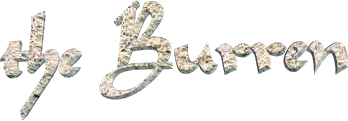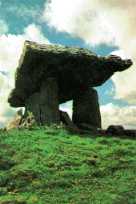
| Introduction | Flora of the Burren |

|
|
Poulnabrone is probably the best known example of a portal tomb in Ireland. A portal tomb usually has two imposing 'portals' or entrance stones, flanking the front of a rather small rectangular chamber. The capstone which rests just on the end stone and on the portal stones is large. This tomb was excavated by Dr. Ann Lynch of the Office of Public in 1986. The excavation of the chamber and part of the surrounding cairn revealed much about the form and structure of the tomb. The orthostats of the chamber were sitting directly on the limestone bedrock held in place by the weight of the capstone like a house of cards. The sill-stone at the entrance to the chamber was sitting in an east-west gryke which formed a natural socket. Its original height is impossible to determine as it fractured sometime in antiquity close to the present floor level, but it may have extended to the underside of the capstone - thereby closing off the burial chamber. At the entrance to the chamber, just outside the sill-stone, three stones had been placed on edge forming a portico- or ante-chamber which had been backfilled with earth and stones shortly after construction. In a report, Dr. Lynch describes the cairn as roughly oval in plan and stated that it seems reasonable to assume that when originally built the carin at Poulnabrone appeared much as it does today. It would seem that the soaring capstone was designed to be seen. From the chamber deposit and from the grykes running through the chamber and the portico- the unburned remains, disarticulated and fragmentary, of between 16 and 22 adults and 6 juveniles, including a newborn baby were recovered. It is estimated that the majority of the adults died before reaching the age of 30 while only one lived past 40 years. Of the 8 adults of whom it was possible to determine sex, there was an equal distribution of males and females. Some of the human bones of Poulnabrone were submitted for radio-carbon dating and the results suggest that burial took place there between 3,800 and 3,200 BC. The skeleton of the newborn baby which had been placed in a crevice, proved to be a later, bronze-age, insertion. It is thought likely that monuments like this must have played some symbolic role, and may have played an integral part in the lives of the community. It may well have been the bones of special dead - perhaps those of revered ancestors who served some function as intermediaries with the gods or spirits who were believed to control the natural world. Other megalithic tombs in the Burren include:
[back] |
 |
© 2005 Villa Maria